Of course, the debates are complex and the contexts diverse and often
starkly different. But, English Touring Opera’s production of Handel’s
Radamisto, currently touring the UK and visiting
cities from Durham in the north to Exeter in the south, seems to suggest
otherwise. Director James Conway’s production does not update the action,
does not consciously seek modern ‘relevance’, respects the score (though
there are some judicious cuts, which ensure that the audience’s stamina is
not over-taxed), and tells the story straight and true. In so doing,
Conway, aided by an accomplished cast, makes the historical dramatically
and emotionally immediate, and ‘real’.
Radamisto
, which premiered at the King’s Theatre on 27 April 1720, was Handel’s
first full-scale opera for the new Royal Academy of Music, and the latter’s
second production. The anonymous libretto (sometimes accredited to Nicola
Haym) was an adaptation of D. Lalli’s L’amour tirannico, o Zenobia (Venice, 1710), which itself drew on
a byway of Roman history as related by Tacitus in his Annals of Imperial Rome.
Characteristically, this opera seria text throws spousal devotion,
patriotic duty, tyrannical lust and tested loyalties into the dramatic
bear-pit. It is the female characters - the abused and long-suffering
Polissena, wife of the Armenian King Tiridate, and Zenobia, the wife of
Tiridate’s brother-in-law, Radamisto, whom the narcissistic, infatuated
Armenian hothead desires as much as he craves the Thracian Radamisto’s
throne - who, as emblems of faithfulness and fortitude, lead us through
cruelties and moral quagmires to resolution, reconciliation and
reassurance. And, Conway, fittingly foregrounds this female duo, providing
motivation and moral focus in the face of some of the libretto’s non
sequiturs and nonsensical sequences.
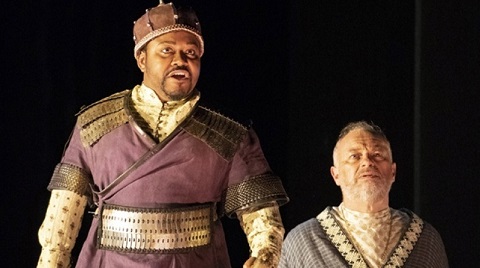 John-Colyn Gyeantey (Tigrane), Andrew Slater (Farasmane). Photo credit: Richard Hubert Smith.
John-Colyn Gyeantey (Tigrane), Andrew Slater (Farasmane). Photo credit: Richard Hubert Smith.
While Radamisto epitomises romantic loyalty and filial duty, the other male
characters prove feckless, flimsy or, in the case of Farasmane, Radamisto’s
deposed father, weakened by imprisonment and humiliation. The character of
Fraate - Tiridate’s brother, who has also desired Zenobia and who
originally facilitated some of the plot mechanisms and motivations - was,
when the opera was revived in December 1720, revised by Handel and then
subsequently eliminated, so Conway’s decision to excise this rather
one-dimensional role seems sensible.
Designer Adam Wiltshire’s set is economical: starkly lit by Rory Beaton
within a surrounding blackness - thereby isolating and sharpening the
characters’ ethical dilemmas and defects - archways and porticos, ramparts
and rockfaces, and some splendid costumes, provide visual definition of
time, place and aesthetic. In the apparent absence of stage-hands, the
characters themselves swivel and slide the large set-pieces: twice William
Towers, immediately after delivering one of Radamisto’s stamina-taxing
arias, had to find a bit more breath and strength to shift a heavy arch or
wall.
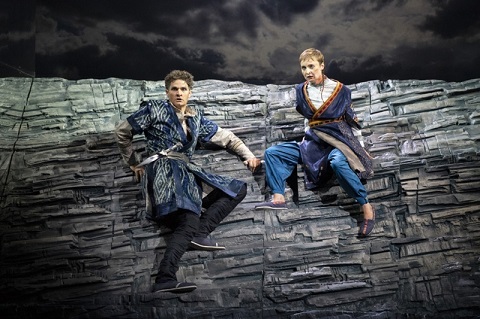 William Towers (Radamisto), Katie Bray (Zenobia). Photo credit: Richard Hubert Smith.
William Towers (Radamisto), Katie Bray (Zenobia). Photo credit: Richard Hubert Smith.
Beaton shines heightening white spotlights on characters as they plunge
emotional depths in their arias, but also makes effective use of colour.
Polissena’s bravura ‘Dopo l’orride procelle’, which ends Handel’s first of
three acts, was set against a screened backdrop of a fateful sky which
transmuted from grey-blue, through lilac and purple, to portentous red. In
Act 2, a towering entrance opening, slashed into the prevailing black,
glowed a fiery orange. And, there were a few scenic effects which surprised
the audience in Snape Maltings Concert Hall: such as when the fleeing
Radamisto and Zenobia seemed to climb into the back-telescreen,
which proved to be not two- but three-dimensional, and scampered agilely up
the precarious mountain face from which Zenobia would throw herself in
suicidal despair.
The title role was originally designed for a low soprano and was sung by
Margherita Durastanti, but for the December 1720 production Handel made
significant changes to Radamisto to suit the new, largely Italian
cast who had arrived in London that year, and the role of the Thracian
prince was taken by the castrato Senesino. Durastanti was renowned for her
wide emotional range, Senesino for the power and sweetness of his voice,
and the refinement of his ornamentation. I found Towers’ Radamisto a little
undefined dramatically at the start - ‘Perfido, di a quell'empio tiranno’,
sung in response to Tiridate’s threats to destroy Farasmene’s city if he
does not relinquish his throne, and Zenobia’s self-sacrificing submission
to Tiridate, might have been more assertive and confident - but the
countertenor ‘grew into’ the role. ‘Ombra fa’ was both technically assured
and inspired our sympathy - all the more so as Towers had to deliver his
show-piece perched upon a precipitous ledge. The duet between Radamisto and
Zenobia which ends Act II was particularly affecting.
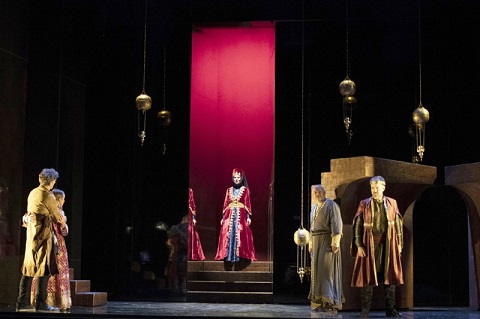 Ellie Laugharne (Polissena, centre). Photo credit: Richard Hubert Smith.
Ellie Laugharne (Polissena, centre). Photo credit: Richard Hubert Smith.
Ellie Laugharne endowed Polissene which dignity and presence, phrasing the
plaintive ‘Sommi dei’ beautifully and singing with lovely expressive tone
and shading. She sometimes seemed a little underpowered in the more rapid
passagework and ‘Sposo ingrato’, in which the Queen challenges her abusive
husband having previously saved him from her brother’s murderous wrath, was
accurate but rather light.
John-Colyn Gyeantey performed the part of Tigrane, Tiridate’s
conscience-stricken but gutless henchman, a role that was originally taken
by soprano Caterina Galerati and which is still frequently sung by a
soprano. Gyeantey’s characterisation was a little pale, but he made a fair
attempt to convey Tigrane’s sincerity as he equivocated between his duties,
passions and morals. The tenor was at his best in the slow passages which
offered spaciousness to allow the beauty of his soft-grained tone to shine.
As his Act 3 aria, ‘So ch’è vana la speranza’, showed, he can give poise to
an emotional moment, but Gyeantey’s tenor lost definition and impact in the
quicker passages and when the recitative was required to carry the drama
forwards.
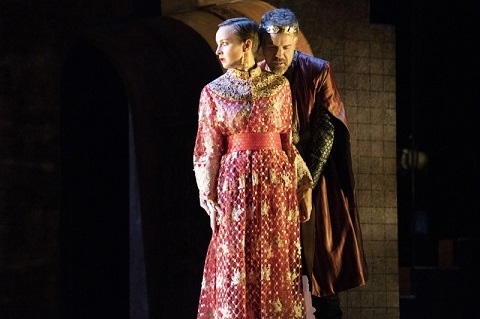 Katie Bray (Zenobia), Grant Doyle (Tiridate). Photo credit: Richard Hubert Smith.
Katie Bray (Zenobia), Grant Doyle (Tiridate). Photo credit: Richard Hubert Smith.
Baritone Grant Doyle blustered appropriately as the psychotically
egotistical Tiridate, reminding us that there are far too many such
hot-headed narcissists in positions of political power today - Conway
describes the Armenian king as ‘perverted by his own unbridled will’ - but
occasionally sounding a little too tonally coarse. Andrew Slater conveyed
Farasmane’s dignity and moral stature as the deposed Thracian monarch was
man-handled around the stage.
The production truly came alive, though, when mezzo-soprano Katie Bray gave
vivid voice to Zenobia’s principled utterances and noble passions, her
scything power and richly coloured nuance sharply etching Zenobia’s
firmness of temperament and political presence. Bray displayed deeply
considered expressivity, too, in ‘Quando mai’, singing with tenderness and
pathos.
Radamisto
is bound to leave the audience with several unanswerable questions. Why
does Polissena continue to love Tiridate despite his vicious tyranny and
heartlessness? Why does Tridate vacillate so spinelessly? Why does Zenobia
throw herself off a mountain peak and then re-appear unscathed? Though
Conway tells the tale straight he can’t overcome all of the libretto’s non
sequiturs and nonsenses: the rapid climactic sequence at the end of Act 3
in which attempted rape is followed by thwarted double-murder, after which
the apparently dead Radamisto revives himself, and which concludes with
Tiridate’s personality-flip and a hastily constructed lieto fine
raised a few chuckles in Snape Maltings, but that’s probably the fault of
Handel’s libretto rather than directorial misjudgement.
Peter Whelan conducted the cast and the Old Street Band from the
harpsichord, the latter improving as the proceedings progressed: after a
slightly murky and dull overture, later we heard much more of the bright
colouring of Handel’s score as flute, oboe and horns made sympathetic
contributions to the drama. The continuo group was elegant led by Whelan
and he was complemented by some gracious theorbo playing from Toby Carr and
a lovely clear line from cellist Gavin Kibble. Whelan pushed the action
swiftly but not precipitously forwards, and the overall result was visual,
vocal and dramatic clarity and cohesiveness.
If only the relationships between the three parts of the triple bill which
was presented the following evening had been so clear. When I spoke to
Thomas Guthrie
recently, prior to his production of
Dido and Aeneas
at the Barbican
, he observed that one issue that must be addressed when staging Purcell’s
opera is the question of which compositions to programme alongside the
opera. Guthrie chose to present a ‘funeral for the late Queen of Carthage’
accompanied by other music by Purcell in the first half of the performance,
so that the opera functioned as a flash-back, taking us ‘behind the
scenes’. Conway and the other two directors presenting this triple bill
have prefaced the Carthaginian Queen’s tragic demise with Giacomo
Carissimi’s oratorio, Jonas, and I Will Not Speak ( Io tacerò) - a sequence of Carlo Gesualdo’s madrigals and
Tenebrae responses, interspersed with readings of poetic and religious
texts.
Seeking a link between these three items (beyond the general concerns with
fate and faith that they might be thought to share), I turned to conductor
Jonathan Peter Kenny’s programme article introducing Carissimi, but could
find nothing to guide me other than the tentative hypothesis that, since
Pepys had recorded his admiration for the Italian composer’s music in his
diary in the late-seventeenth century, and the latter’s music had been
copied into English manuscripts such as those preserved at Christ Church
Oxford, then, as Purcell had made his own copies of works by Monteverdi and
Cazzati, he ‘must surely have seen the examples of Carissimi’. Perhaps; but
if so, with what effect, and to what end here?
Carissimi’s Jonas is one of the oratorio volgare (in
Italian, as opposed to the oratorio latino, in Latin) that he
composed for performance before the religious elite in the Santa Crocificio
Oratory in Rome. Carissimi composed fifteen or so such works, labelling
them historioe: that is, they presented narrative
accounts of episodes drawn from the Bible - here, Jonah’s encounter with
the whale - in which drama is created by the juxtaposition of
varied musical forms - choral narration, madrigalian songs and duets, a
solo lament, instrumental episodes - and language, homophony alternating
with imitation.
 Jorge Navarro-Colorado (Jonas). Photo credit: Richard Hubert Smith.
Jorge Navarro-Colorado (Jonas). Photo credit: Richard Hubert Smith.
That master of the genre, George Frideric Handel, borrowed from Carissimi
in some of his own oratorios. In recent times we have become used to seeing
some of the latter staged, and here director Bernadette Iglich offered an
attempt to impose visual and kinetic ‘theatre’ on music which has its own
inherent drama. The eight performers, dressed in drab-coloured tunics and
representing the ‘wicked’ community of Nineveh, moved with ritualistic
solemnity around an unidentifiable column amid a blackness worthy of the
leviathan’s belly, reflecting on faith and doubt.
The most obviously ‘dramatic’ incidents the biblical tale seem of little
interest to Carissimi, though he does provide a colourful, explosive
storm-scene which was vibrantly played by the Old Street Band. The
composer’s focus is instead the doubts and equivocation of the protagonist.
Jonah’s aria of supplication from inside the belly of the whale is the
expressive climax, and it was beautifully sung by Jorge Navarro Colorado,
the refrain, ‘Placare Domine’ (Subside your anger, Lord) powerful and
moving.
Stirring singing during double-choir storm chorus was complemented
elsewhere by the ensemble’s lovely, melodious blend and the text was
carefully enunciated, especially in the closing chorus of repentance which
follows the abrupt conversion of Ninevites - a fitting moral message for
the departing congregation at the Oratorio del Santissimo Crocifisso to
carry with them but perhaps, judging from the responses around me, not
quite such apt fulfilment of the expectations of those in Snape Maltings
Concert Hall.
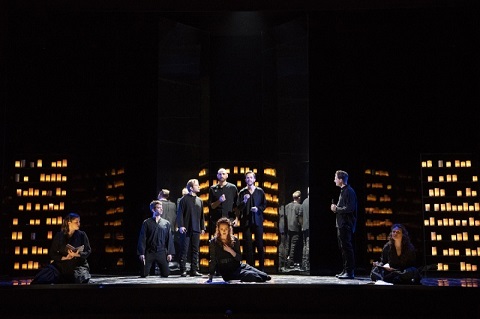 I Will Not Speak. Photo credit: Richard Hubert Smith.
I Will Not Speak. Photo credit: Richard Hubert Smith.
In I Will Not Speak, Conway sought to explore the interweaving and
fusing of sensuality and spirituality, violence and virtue in the works of
Gesualdo - a man renowned for the brutal murder of his adulterous wife,
Maria D’Avalos. I’m not sure if one could say that the sequence was
‘staged’. Votive candles fluttered - a representation of the special
candelabrum with fifteen candles which were distinguished one by one as
each day’s service, commencing at nightfall, began, until only a single
Paschal Candle remained; and also a metaphor for the quivering, fervent
dialogue between faith and doubt. And, there was a slow ritual progress
amid the flickering tiers of orange light, as the shadows multiplied and
deepened until God plunged the world into darkness, the Crucifixion
extinguishing the light of the world.
In any case, I cannot see any reason for adding dramatic action or movement
to these works. There is enough melodrama within the madrigals,
dominated as they are by a love which burns with the heated passion of a
self-consuming destructive desire, and the Tenebrae Responses, which seek
to bring human darkness and despair into balance with the hope of
forgiveness and rebirth. Indeed, the music seems to express such
interiorised agonies and ecstasies that all such external events are
negated. Certainly, gestures such as a blowing of breath at the start of
John Donne’s ‘The Expiration’ seemed somewhat trite. And, it seems all too
perfunctory to make a direct link between Gesualdo’s tragic destiny and the
torments of his musical voice, such as was intimated by the recitation of
episodes of the composer’s life amid extracts from the Psalms,
Igantius Loyala’s Spiritual Exercises, and The Spiritual Canticle of St John of the Cross.
Perhaps the chromatic distortions and intensities find their complement in
the bitter, often self-lacerating arguments of the metaphysical texts of
John Donne and George Herbert, but the conflicts expressed therein are
those of a single voice, and the division of the poetic lines between
different voices weakened this interior drama. The singers again performed
assuredly, accompanied predominantly by strings, but the sweetness of the
blended timbre denied the astringent dissonances their full power.
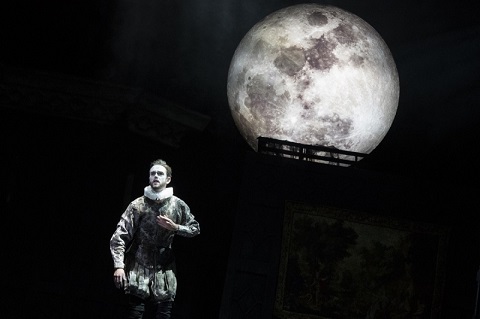 Nicholas Mogg (Aeneas). Photo credit: Richard Hubert Smith.
Nicholas Mogg (Aeneas). Photo credit: Richard Hubert Smith.
Seb Harcombe’s Dido and Aeneas promised to restore the
musico-dramatic equilibrium. Designer Adam Wiltshire presented us with the
crumbling ruins of a Tudor manor - a metaphor for ravaged Carthage,
perhaps. But, even here there was ambivalence. Harcombe professed to have
viewed the opera ‘from inside the heroine’s mind’ - I guess that explains
why this Dido was staring into a hand-mirror at the start, and resumed this
position before the tilting fire-place/portico at the close - and there was
a disconcerting disjuncture between the realism of the Elizabethan
costumes, all stiffly starched ruffs and cod-pieces, and the
pseudo-psychodrama of much of the Gothic gestures and lighting.
There were a few doubtful moments: I’m not sure that witnessing Aeneas’s
rather rough wooing and writhing with his new amour to the accompaniment of
the theorbo’s elaborate, but not very erotic, ground bass repetitions, was
a substitute for the imagined mysteries of The Cave. But, despite this the
truly fine singing won the day. Susanna Fairburn’s terrifically vivid
Belinda was a good counterfoil for Sky Ingram’s depressive Queen: the
latter’s dull tunic and tortured visage brought to mind the heroines of the
Brontës, and the rich timbre of Ingram’s lower range was evocative of the
profound passions and neuroses of Jane Eyre and Cathy Earnshaw. Nicholas
Mogg’s Aeneas was an oddly indifferent courtier and courter, egoism rather
than empathy taking precedence as he entered with the flourish of a Walter
Raleigh or the Earl of Essex, presenting the Queen with a model ship which
honoured his own adventuring and achievements. Long, lank black locks made
the sonorous announcement of Frederick Long’s Sorceress even more
surprising and chilling than usual.
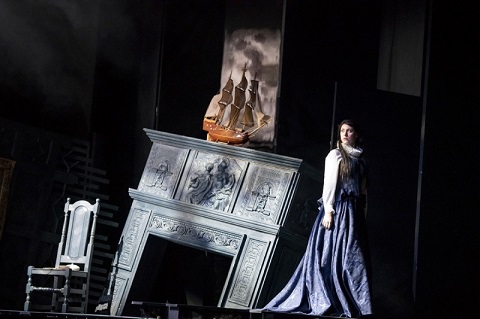 Sky Ingram (Dido). Photo credit: Richard Hubert Smith.
Sky Ingram (Dido). Photo credit: Richard Hubert Smith.
The small forces necessitated some compromises and excisions. The doubling
up of Dido’s court and the coven of witches might have been thought to
support Harcombe’s hypothesis that the events were conjured by Dido’s
damaged psyche. But, the need for Dido to join the chorus, after Belinda’s
‘So fair the game, so rich the sport’, to help full out the sound, was less
convincing. Moreover, the score’s joyful moments and carefree pastoralism
seemed diluted.
During the final chorus, Dido rose and wandered, lost and unheeded through
the ‘mourners’: perhaps the latter had already forgotten their Queen’s
admonishment to ‘remember’? I’m not sure that this triple bill, beautifully
sung but of dubious rationale and relevance - an encore, surely not
necessary or appropriate after this most ‘perfect’ of operas, from
Carissimi’s Jephtha seemed to return us to the staticism of
earlier in the evening - will be one of my most vivid ETO memories.
But, Radamisto the night before had provided splendid enjoyment
and fulfilment. And, I look forward to ETO’s spring tour, which presents
three operas - Mozart’s Idomeneo, Rossini’s Elisabeth I,
and Verdi’s Macbeth - in which still more Kings and Queens in
battle for love, loyalty and power.
In the meantime,
ETO’s autumn tour
continues until 28th November.
Claire Seymour
Handel:
Radamisto
English Touring Opera: Radamisto - William Towers, Zenobia - Katie Bray,
Polissena - Ellie Laugharne, Tiridate - Doyle Grant, Tigrane - John-Colyn
Gyeantey, Farasmane - Andrew Slater; Director - James Conway, Conductor -
Peter Whelan, Designer - Adam Wiltshire, Lighting designer - Rory Beaton,
The Old Street Band.
Snape Maltings Concert Hall, Snape, Suffolk; Friday 2nd November
2018.
Purcell: Dido and Aeneas; Carissimi - Jonas; Gesualdo:
I Will Not Speak
Dido - Sky Ingram, Aeneas - Nicholas Mogg Belinda - Susanna Fairbairn,
Sorceress - Frederick Long, Spirit - Benjamin Williamson, Second Woman -
Alison Manifold, Sailor - Richard Dowling, Jonas -Jorge Navarro-Colorado;
Director (Dido) Seb Harcombe, Director (Jonas) Bernadette Iglich, Director
(I Will Not Speak) James Conway, Conductor - Jonathan Peter Kenny, Designer
- Adam Wiltshire, Lighting Designer - Rory Beaton, The Old Street Band.
Snape Maltings Concert Hall, Snape, Suffolk; Saturday 3rd October 2018.








